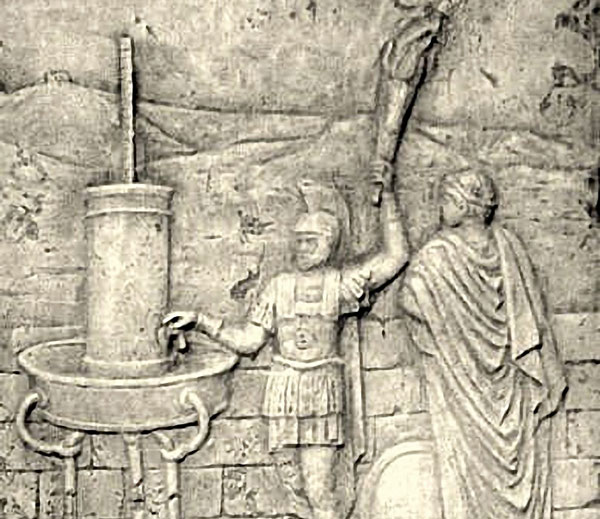In the 4th century BC, a Greek named Aeneas invented a hydraulic telegraph that allowed people to communicate over long distances. The method of constructing and operating this device was relatively simple but highly effective for communication.
Advancements in technology have significantly changed our lives today compared to the distant past. Thanks to modern devices, we can easily communicate with others over long distances or connect with large groups of people. By looking back at ancient civilizations, we gain deeper insights into the first long-distance communication methods used by humans.

Relief of Aeneas’ hydraulic telegraph. Photo: Wikimedia
In 350 BC, Aeneas invented the hydraulic telegraph—a communication tool that quickly conveyed important and detailed information over long distances.
Aeneas was a Greek writer knowledgeable about military history, strategy, and communication. He was one of the first authors to provide guidance on military communication. This invention was significant in facilitating the exchange and transmission of military tactics and strategies during wartime or in the event of sudden attacks.
Prior to this, Aeneas had been frustrated by the limitations of communication methods using torches and beacons. Torches could convey some messages, such as warnings of danger or notifications that a task was completed, but they could not send messages with clear content.
Aeneas developed the hydraulic telegraph to address these issues. In his work “The Histories,” the Greek historian Polybius described Aeneas’ invention in detail. The hydraulic telegraph consisted of a large cylindrical water tank and a vertical rod floating above the water’s surface. On the rod, pieces of paper with pre-encoded messages, such as “cavalry advancing” or “warship present,” were affixed sequentially.
Two telegraphs would be placed at locations far apart but still within sight of an observer, usually on the top of a hill. When one party wanted to send a message to the other, they would raise a torch. If the second party saw the raised torch, they would also raise their torch to confirm they were ready to receive the message. At the moment the first sender lowered their torch, both parties would simultaneously turn the faucet at the bottom of the tank to lower the water level.
When the piece of paper with the intended message reached the top edge of the tank, the sender would light their torch again, signaling the receiver to close the faucet and read the message on the paper aligned with the tank’s edge.
To ensure the information was transmitted fully and accurately, both parties [the sender and receiver] had to use tanks of the same size, containing the same volume of water, and rods with identical messages. The sender and receiver also had to operate very precisely, starting and stopping the water flow at the same time.
Although the construction of the hydraulic telegraph seemed simple, this invention represented a significant advancement in ancient communication technology, allowing messages to be sent over long distances. In the event of an enemy invasion or approach, they would only see the light of the signal torch and could not intercept the messages in any way.
This was also a major advancement in military strategy. During the First Punic War (264–241 BC), messages sent from the city of Sicily to Carthage via the hydraulic telegraph system helped the Roman army achieve significant victories.
Through the hydraulic telegraph, groups of soldiers could communicate specific messages to each other, as well as receive intelligence from civilians to better prepare for potential invasions by enemies by land or sea.
Over time, this first form of long-distance communication was gradually improved, paving the way for modern communication methods widely used today.
By the 19th century, British engineer Francis Whishaw developed a new type of hydraulic telegraph that operated entirely on fluid pressure. It had a structure similar to Aeneas’ design, but Whishaw added a water-filled pipe to connect the transmitting and receiving devices [instead of using torch signals as before]. Changes in pressure at the transmitting device would result in changes in water levels at the receiving device, allowing the observer to read the intended message written on a piece of paper.
The limitation of this device was that it could not operate in temperatures below 0 degrees Celsius, as the water in the pipe could freeze. This was the main reason Whishaw’s device was never used in practice, apart from testing over very short distances.
In 1835, Samuel Morse successfully created a telegraph machine that used electric pulses to transmit encoded messages through wires or radio waves. This device operated using Morse code, in which each letter and number is represented by dots and dashes. The sender first needed to encode the text message into Morse code. This code was then converted into electric pulses through telegraph keys that moved up and down to open or close the circuit between the battery [of the transmitter] and the receiver. The signal traveled through the wire as a series of electric pulses. Finally, the receiver on the other end would convert the electric pulses back into dots and dashes as originally intended, allowing the recipient to understand the message.
Morse’s telegraph was later widely adopted for many reasons, the most notable being its simple operation and relatively low manufacturing costs. Over time, the Morse code he developed gradually became the primary language of telegraphy worldwide.
Throughout the 20th century, telegraph technology was gradually replaced by cheaper long-distance communication services, such as telephones, fax machines, and email.


















































